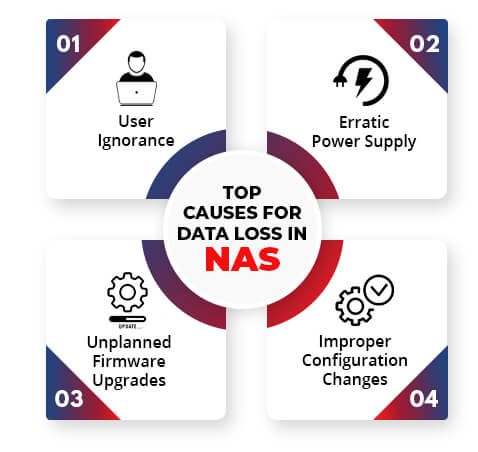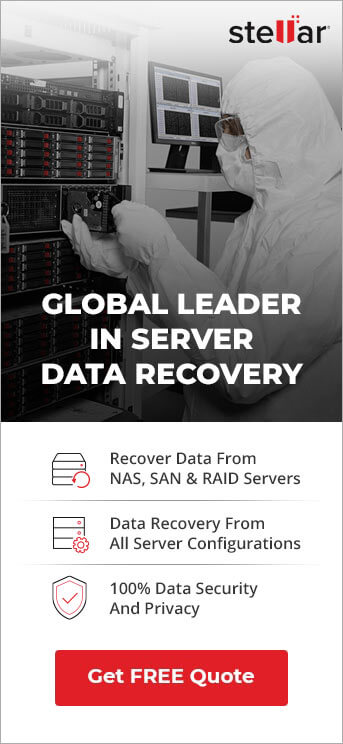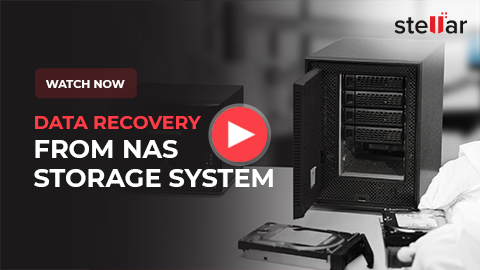Chapter 3 of 5 | Published On
In the last chapter, we learned about:
- Some of the scenarios where organisations find the performance of NAS insufficient,
- The working of SAN, and
- The difference between NAS and SAN, and the advantages of SAN.
In this chapter, we'll learn about:
The limitations of NAS
- The key causes of data loss in NAS,
- Why users must not experiment with NAS configurations, and
- Best practices of avoiding data loss.
NAS And The Risk Of Data Loss
Where there's storage, there's data. And where there's data, there's the risk of data loss.
It's the same with NAS.
In fact, you could lose data in your NAS because of any of these 25+ causes.
| NAS RAID Failure | Physical Damage to HDD | Human Action Error | Logical Error |
|---|---|---|---|
|
Overheating of NAS and its hard drives
|
Bad sectors on drive | Accidental/unintended deletion of folders and files | Improper shutdown |
| Overheating of NAS and its hard drives | Read/write Head failure | Formatting of partition | Abrupt power failure or voltage fluctuations |
| Incorrect RAID configuration | Corrupt firmware | Overwriting Database files | Incomplete operations |
| RAID Array failed | Multiple drive failure | Incorrect setup | Unable to Boot up |
| Server registry configuration error | Platter scratching | Unauthorized access to files and folders | Resetting the system |
| Malfunctioned controller | Failing head assembly | Operating system errors | |
| Damaged PCB (Printed Circuit Board) | Deletion of tables |
We’ll explain the most common of these.
Invariably, businesses use NAS to store their most important data. Loss of this data cripples their operations. That’s why it’s important to know why this happens, so that:
- You can avoid data loss in NAS, and
- You know what to do when you lose your NAS data.
Also Read : Stellar® Recovers Data from Physically Failed Netgear NAS
.jpg)
Top Causes For Data Loss In NAS
User Ignorance
Inherently NAS devices are robust. However, they're not the most intuitive devices for users.
A lot goes inside a functional NAS setup—the NAS box, hard drives, RAID configuration, data transfer protocol, Ethernet, etc.
Dozens of processes spring into action with every read and write request. And the chain could break at any of its links.
When a user tries to handle a NAS system without understanding the entire process, they create massive risks. And that's why we see so many instances of data loss from NAS devices.
NAS boxes are commonly used by individual users. Still, they aren’t as intuitive as storage devices like hard drives, SSDs, and USB sticks.
You could easily commit a mistake that can trigger a sequence of events that end in the loss of data from your NAS. We’ve covered some of these in the subsequent sections.

Erratic Power Supply
The three common power supply problems are:
- Power failure,
- Voltage fluctuation, and
- Overvoltage.
Let's imagine a situation wherein your NAS box goes off frequently without power. It's possible that in one such instance, any one of the out-of-sync disks in your NAS won’t reintegrate properly into the RAID. This could trigger a system-wide
failure, part of which could be data loss from one or more drives.
In some cases, the RAID metadata might be lost, which can trigger a volume failure (wherein users are unable to find shared folders in the web interface of the storage).
Sometimes, an erratic power supply can result in the loss of the partition table. In such a case, your RAID might not even boot up.
Even voltage fluctuations and over-voltage could trigger the same events.
Within businesses, it’s common practice to connect NAS boxes with Uninterrupted Power Supply (UPS) units.
When you encounter any of the above-mentioned problems, don’t be tempted to experiment with the admin console. Instead, refer to the official troubleshooting guide, or talk to a NAS expert.
Generally, such issues can be resolved by:
- Disconnecting your NAS drives,
- Recovering lost data using logical recovery methods,
- Reconnecting the drives, and
- Reconfiguring the NAS and RAID.
DIY troubleshooting tactics such as replacing NAS drives could render the NAS system incompatible with the network.
If you've already lost data, don't experiment at all. Immediately engage a NAS data recovery expert.
Unplanned Firmware Upgrades
Sometimes, users can trigger unintended firmware upgrades.
Sometimes, even an intended firmware upgrade is done in an unplanned manner.
And sometimes, a support professional may recommend (or carry out) a firmware upgrade without backing up NAS data.
In all three situations, you could end up losing your data.
That's because NAS firmware updates are tricky and can easily go wrong.
A firmware upgrade may change the rules of data storage, and render all stored data inaccessible.
A firmware upgrade may cause the creation of a new file system which can make your data inaccessible
The best practices are:
- Don't carry out NAS firmware upgrades without technical supervision.
- If your data is inaccessible after a firmware upgrade, get professional NAS data recovery help, because timely action is crucial.
- If you want to upgrade the NAS firmware to solve a different problem, backup your data before you proceed.
Improper Configuration Changes
NAS is a live system. Any major change done to the live system comes with risks.
For instance, several users find that when they replace a hard drive in a NAS, or add another hard drive, the NAS functionality is affected. This happens when there are problems during the RAID rebuilding process after a storage upgrade.
Even something as trivial as a power disruption during RAID rebuilding can make data on some drives inaccessible.
Other Causes Of Data Loss In NAS
If you bought a NAS box with unbranded pre-fitted hard drives, you're vulnerable to inadvertent system breakdowns. Even one misfiring hard drive in a NAS
can cause data loss. Your best recourse today is to copy data from such unreliable hard drives to a branded hard drive and replace it in your NAS.
In a NAS box, maximum speed and performance come at the cost of redundancy (data duplication). The components of a non-redundant NAS are more vulnerable to data loss because there's no built-in protection.
Breakdown of the cooling system of the NAS box, aggravated by poor ventilation, could trigger a NAS failure.
Your NAS admin console will alert you of potential issues with settings, RAID configuration, and storage. Never ignore these messages. Timely remedial action can save you weeks of misery when you
lose your data.
How To Deal With A NAS Data Loss Situation?
Remember, RAID 10 configuration doesn't guarantee complete data security. Maintain offsite backup of your crucial data.
The golden rule is—don't experiment with your NAS configuration. If you can't access your data, immediately seek professional help. DIY and experimentation can easily aggravate your data loss situation.
At Stellar, we're used to receiving urgent data recovery requests for NAS with all kinds of RAID configurations. The data loss—in 9 out of 10 cases—is remedied by a combination of logical recovery methods (using software) and physical recovery methods (involving hard drive part transplantation).
Also Read : How to Fix NAS Device Not Visible On Windows 10?





